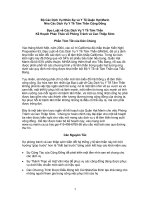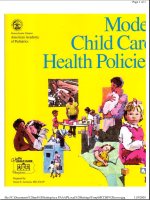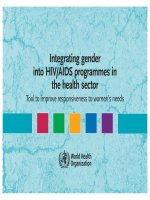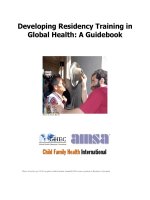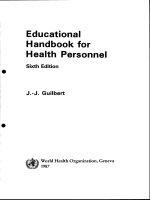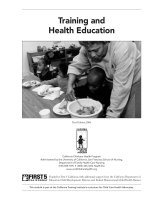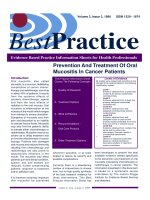Global health watch 3 an alternative world health report ppt
Bạn đang xem bản rút gọn của tài liệu. Xem và tải ngay bản đầy đủ của tài liệu tại đây (5.16 MB, 391 trang )
GLOBAL HEALTH WATCH
AN ALTERNATIVE WORLD HEALTH
REPORT
Global Health Watch
Zed Books
|
Global Health Watch 3: An Alternative World Health Report was first published in
by Zed Books Ltd, Cynthia Street, London , and Room ,
Fifth Avenue, New York, ,
www.zedbooks.co.uk
Copyright © People’s Health Movement, Medact, Health Action International,
Medicos International and Third World Network,
The right of People’s Health Movement, Medact, Health Action International,
Medicos International and Third World Network to be identified as authors of
this Work has been asserted by them in accordance with sections and of
the Copyright, Designs and Patents Act
Set Monotype Plantin and FontFont Kievit by Ewan Smith, London
Index: …
Cover designed by Jason Anscombe, Rawshock Design
Printed and bound in Great Britain by …
Distributed in the exclusively by Palgrave Macmillan, a division of
StMartin’s Press, , Fifth Avenue, New York, ,
All rights reserved. No part of this publication may be reproduced, stored
in a retrieval system or transmitted in any form or by any means, electronic,
mechanical, photocopying or otherwise, without the prior permission of Zed
Books Ltd.
A catalogue record for this book is available from the British Library
Library of Congress Cataloging in Publication Data available
hb
pb
CONTENTS
Boxes, tables, charts | vii Photographs | ix
Acronyms | ii Acknowledgements | ii
Introduction . . . . . . . . . . . . . . . . . . . . . .
The global political and economic architecture
A Economic crisis and systemic failure: why we need to rethink
the global economy . . . . . . . . . . . . . . . . . . . .
Health systems: current issues and debates
B Primary health care: a review and critical appraisal of its
‘ revitalisation’ . . . . . . . . . . . . . . . . . . . . .
B Financing health care: aiming for long-term solutions. . . . . .
B Health financing models that make health systems work: case
studies from Costa Rica, Sri Lanka and Thailand . . . . . . .
B Dysfunctional health systems: case studies from China, India
and the US . . . . . . . . . . . . . . . . . . . . . .
B Achieving a shared goal: free universal health care in Ghana . . .
B Maternal mortality: need for a broad framework of intervention. .
B Research for health . . . . . . . . . . . . . . . . . . .
B Pandemic influenza preparedness: in search of a global health
ethos . . . . . . . . . . . . . . . . . . . . . . . .
B Mental health and inequality . . . . . . . . . . . . . . .
Beyond health care
C The global food crisis . . . . . . . . . . . . . . . . . .
C Health information, conflict, and the right to health . . . . . .
C Trade and health. . . . . . . . . . . . . . . . . . . .
C The future is now: genetic promises and speculative finance . . .
C Climate crisis . . . . . . . . . . . . . . . . . . . . .
C Challenging the population: climate connection . . . . . . . .
Watching
D World health organisation: captive to conflicting interests . . . .
D UNICEF and the ‘medicalisation’ of malnutrition in children . .
D Conflicts of interest within philanthrocapitalism . . . . . . . .
D The pharmaceutical industry and pharmaceutical endeavour . . .
D Health and global security: reasons for concern . . . . . . . .
D The international health partnership+: glass half full or half
empty?. . . . . . . . . . . . . . . . . . . . . . . .
D New reproductive technologies . . . . . . . . . . . . . .
Resistance, actions, and change
E The movement for change . . . . . . . . . . . . . . . .
E The right to health: from concept to action. . . . . . . . . .
E Cuba’s international cooperation in health . . . . . . . . . .
Contributors |
Index |
BOXES, TABLES, CHARTS
Boxes
PHC and the Aboriginal community in australia . . . . . . . . .
The politics of aid . . . . . . . . . . . . . . . . . . . . .
Overview of the health system in ghana. . . . . . . . . . . . .
. Human rights and maternal mortality . . . . . . . . . . . . .
. Institutional deliveries – not a panacea . . . . . . . . . . . . .
. Alternative indicators of social progress. . . . . . . . . . . . .
. Cooperative research centre for Aboriginal health . . . . . . . . .
What is a futures market? . . . . . . . . . . . . . . . . . .
Death and injury in conflict: who, when, and where . . . . . . . .
. ‘TRIPS plus’ measures in FTAs . . . . . . . . . . . . . . .
FTAs – the devil lies in the details. . . . . . . . . . . . . . .
. Plumpy’nut and patents . . . . . . . . . . . . . . . . . .
. From Ann Veneman to Anthony Lake . . . . . . . . . . . . .
. The great vitamin A fiasco. . . . . . . . . . . . . . . . . .
Medicines in search of a disease . . . . . . . . . . . . . . .
Signatories of IHP+ . . . . . . . . . . . . . . . . . . . .
. The international people’s health university . . . . . . . . . . .
. Changing from within . . . . . . . . . . . . . . . . . . .
. Campaign on patients’ rights. . . . . . . . . . . . . . . . .
. RTH campaign in Guatemala . . . . . . . . . . . . . . . .
. Fighting for the human right to health care in the United States . . .
Tables
. Costa Rica: expenditure on health: comparison with some Latin
American countries . . . . . . . . . . . . . . . . . . . .
. Comparison of development indicators (by the late s): Sri Lanka
with other regions . . . . . . . . . . . . . . . . . . . . .
. Sri Lanka – key health indicators
. Sri Lanka – share of health expenditure by function and source in
. . . . . . . . . . . . . . . . . . . . . . . . . .
. Thailand: progress in health insurance coverage . . . . . . . . .
. Catastrophic expenditure by households, – . . . . . . . .
. Share of households’ OOP and drug spending in India, / . . .
. India: out-of-pocket expenditure on health care: / and
/ . . . . . . . . . . . . . . . . . . . . . . . . .
viii | , ,
Charts
. World real GDP and trade growth, – . . . . . . . . . .
. World fuel prices, –. . . . . . . . . . . . . . . . .
. World cereal prices, – . . . . . . . . . . . . . . . .
. Linkages between crises and root causes . . . . . . . . . . . .
. Growth of global fossil fuel CO emissions . . . . . . . . . . .
. Net private financial flows (excluding direct investment), developing
countries, –. . . . . . . . . . . . . . . . . . . .
. Tertiary enrolment ratios and tertiary migration (rates by income
level, ) . . . . . . . . . . . . . . . . . . . . . . .
. Sources of health care financing, selected low and middle income
countries, . . . . . . . . . . . . . . . . . . . . . .
. The rapid removal of health user fees in Africa since . . . . .
. Average tax revenues by country income levels, . . . . . . .
. Costa Rica: total expenditure and general government expenditure
on health as a percentage of GDP . . . . . . . . . . . . . . .
. Sri Lanka: public expenditure on health as a percentage of GDP,
– . . . . . . . . . . . . . . . . . . . . . . . .
. Share of government and private health expenditure in Thailand,
– . . . . . . . . . . . . . . . . . . . . . . . .
. Health expenditure in India, / . . . . . . . . . . . . .
. Public expenditure on health in India (as percentage of GDP) . . . .
. Health insurance coverage in India, . . . . . . . . . . . .
. Regional distribution of maternal deaths . . . . . . . . . . . .
. Number of undernourished people worldwide . . . . . . . . . .
. Price volatility of food grains . . . . . . . . . . . . . . . . .
. Changes in wheat price . . . . . . . . . . . . . . . . . . .
. Primary commodity prices and OTC futures contracts . . . . . . .
. Fair and actual share of carbon budget available . . . . . . . . .
. Control over the carbon budget by delaying deep cuts in emissions . .
. Sources of voluntary contributions to WHO’s budget . . . . . . .
. Breakdown of contributions by member states to WHO’s budget –
–. . . . . . . . . . . . . . . . . . . . . . . .
. Six domains of global governance . . . . . . . . . . . . . . .
. ‘Good’ ratings for village-level health services across villages
in Maharashtra over three phases of CBM . . . . . . . . . . .
. Improvement in immunisation services over three phases of CBM . .
PHOTOGRAPHS
Construction boom in China (Chongging) . . . . . . . . . . .
Sign on a building in the US, November . . . . . . . . .
Anti-WTO protests in Hong Kong . . . . . . . . . . . . . .
Police stop ant-G protestors in Rome, May . . . . . . . .
Rag-pickers in Nairobi, Kenya: social and economic development
are key components of PHC . . . . . . . . . . . . . . . .
Woman in a shanty in Cape Town, South Africa: persisting social
and economic inequity in LMICs . . . . . . . . . . . . . .
Demise of primary health care. . . . . . . . . . . . . . . .
Rally for equity in health at Peoples Health Assembly, Cuenca,
Ecuador, . . . . . . . . . . . . . . . . . . . . . .
Medical college in Tianjin . . . . . . . . . . . . . . . . .
Demonstration for free health care in India . . . . . . . . . . .
Separation of health financing and provisioning can mean public
financing of the private sector . . . . . . . . . . . . . . . .
Memorial to Rudolph Virchow in Berlin . . . . . . . . . . . .
Demonstration for health care reform in the US, October . . .
Women’s health problems are often seen only in relation to child-
bearing . . . . . . . . . . . . . . . . . . . . . . . .
Women patients at a hospital in Madhya Pradesh, India where several
deaths took place over a short period . . . . . . . . . . . . .
Research on broader determinants of health is neglected . . . . .
Health research is not prioritised. . . . . . . . . . . . . . .
Flaws in the peer review system . . . . . . . . . . . . . . .
Man with a mask to protect against influenza in a subway in Buenos
Aires, June, . . . . . . . . . . . . . . . . . . . . .
Contrary to claims the food crisis was not brought about by increased
demand in India and China. . . . . . . . . . . . . . . . .
Biofuels have taken over agricultural land . . . . . . . . . . .
Ethanol bio fuel refinery . . . . . . . . . . . . . . . . . .
Paddy field in Hechuan, China. . . . . . . . . . . . . . . .
Activists demanding equitable access to food: US Social Forum,
Atlanta, . . . . . . . . . . . . . . . . . . . . . .
Tamil protestors in Geneva demonstrating against military operations
in Sri Lanka, February . . . . . . . . . . . . . . . .
Demonstration by HIV+ve groups against Indo-EU FTA, New Delhi
x |
Free trade or unfair trade? . . . . . . . . . . . . . . . . .
The counterfeit confusion . . . . . . . . . . . . . . . . .
Protest in New Delhi against introduction of genetically modified
brinjal . . . . . . . . . . . . . . . . . . . . . . . . .
Much of biotech research does not address real needs. . . . . . .
Dry and barren landscape . . . . . . . . . . . . . . . . .
Electric lines criss-cross over a remote village in India; access to
energy is still a huge problem in developing countries . . . . . . .
Climate change demonstration in Copenhagen, December, . .
Demonstration in Geneva at the World Health Assembly, May, .
WHO is unfairly chracterised as just a technical agency . . . . . .
WHO’s role as an independent organisation is at risk . . . . . . .
Two malnourished Nigerian children during the Nigerian-Biafran
civil war, : not enough has changed in many parts of the world
in the last decades. . . . . . . . . . . . . . . . . . . .
Homeless woman with child in New Delhi, . . . . . . . .
Child in Senossa, Mali. . . . . . . . . . . . . . . . . . .
Generic medicines shop in Chittorgarh, India: outcome of an
innovative programme by the administration to promote generic
medicines . . . . . . . . . . . . . . . . . . . . . . .
Drugs in search of a disease. . . . . . . . . . . . . . . . .
Patient undergoing egg retrieval procedure . . . . . . . . . . .
Statue commemorating end of slavery, Goree Island, near Dakar,
Senegal . . . . . . . . . . . . . . . . . . . . . . . .
Indigenous people celebrate at the Peoples Health Assembly in
Cuenca, Ecuador, . . . . . . . . . . . . . . . . . .
Participants at the International Peoples Health University in a march
in Dakar, Senegal, January, . . . . . . . . . . . . . . .
Children demand right to health at a demonstration by peoples health
movement in South Africa . . . . . . . . . . . . . . . . .
Public hearing on right to health in Maharashtra, India . . . . . .
Community based monitoring of health services, India . . . . . .
Signature campaign on patient’s rights in India . . . . . . . . .
Right to health campaign in South Africa . . . . . . . . . . .
Cuban doctors in Haiti after the earthquake, . . . . . . . .
Health activists before the Latin American University in Havana . .
Students at the Latin American University in Havana . . . . . . .
ACRONYMS
ACTA Anti-Counterfeiting Trade Agreement
ART assisted reproductive technologies
BIS Bank for International Settlements
CBHI community-based health insurance
CBM community-based monitoring
CBO community-based organisation
CCSS Caja Costarricense de Seguro Social (Social Security
Administration in Costa Rica)
CFTC Commodity Futures Trading Commission
CGHS Central Government Health Scheme (in India)
CHAG Christian Health Association of Ghana
CHPS Community-based Health Planning and Services (in Ghana)
CHW Community Health Worker
CMS Cooperative Medical Scheme (in China)
COP Conference of Parties
CPHC comprehensive primary health care
CRCAH Cooperative Research Centre for Aboriginal Health (Australia)
CSDH Commission on Social Determinants of Health
CSI Centre for International and Intercultural Health
CSMBS Civil Servant Medical Benefit Scheme (in Thailand)
DEVTA De-worming and Enhanced Vitamin A
DfID UK Department for International Development
DHS Demographic and Health Survey
DNA Deoxyribonucleic Acid
DPT Diphtheria, Pertussis, Tetanus
DSM Dispute Settlement Mechanism
EBAIS Equipos Básicos de Atención Integral en Salud (primary health
care clinics in Costa Rica)
EFPIA European Federation of Pharmaceutical Industries and
Associations
ELAM Latin American School for Medical Sciences
ESIS Employees State Insurance Scheme (in India)
EU European Union
EWG Expert Working Group
FAO Food and Agriculture Organisation
FTA Free Trade Agreement
xii |
GAIN Global Alliance for Improved Nutrition
GATS General Agreement on Trade in Services
GATT General Agreement on Taris and Trade
GAVI Global Alliance for Vaccines and Immunisation
GDP gross domestic product
GFATM Global Fund for AIDS, TB and Malaria
GHG greenhouse gas; global health governance
GHI Global Health Initiatives
GHP Global Health Programmes
GHW Global Health Watch
GISN WHO Global Influenza Surveillance Network
GNP gross national product
GOBI Growth Monitoring, Oral Rehydration Therapy, Breast Feeding
Promotion, Immunisation
GPA Government Procurement Agreement
GPPI global public–private initiative
GSK GlaxoSmithKline Pharmaceuticals Limited
GSPOA Global Strategy and Plan of Action
HDI Human Development Indicators
HDR Human Development Report
HLTF High-level Taskforce for Innovative Financing
IADB International American Development Bank
ICH International Conference on Harmonisation of Technical Re-
quirements for Registration of Pharmaceuticals for Human Use
ICPD International Conference on Population and Development
IFPMA International Federation of Pharmaceutical Manufacturers’
Association
IGWG Inter-Governmental Working Group
IHP International Health Partnership
IHP+ International Health Partnerships plus
ILO International Labour Organisation
IMF International Monetary Fund
IMPACT International Medical Products Anti-Counterfeiting Task Force
IMR Infant Mortality Rate
INTERPOL International Criminal Police Organisation
IPCC Intergovernmental Panel on Climate Change
IPHU International People’s Health University
IPR intellectual property rights
IU International Unit
IVACG International Vitamin A Consultative Group
IVF In Vitro Fertilisation
JPMA Japan Pharmaceutical Manufacturers Association
LIC low-income country
| xiii
LMIC low- and middle-income country
MCH maternal and child health
MDG Millennium Development Goals
MMR maternal mortality rate
MNC multinational corporation
MSA medical savings accounts
MSF Médecins Sans Frontières
MTAs material transfer agreements
MWS Medical Welfare Scheme (in Thailand)
NAIHO National Aboriginal Islander Health Organisation (Australia)
NCMS New Cooperative Medical Scheme (in China)
NGO Non-Governmental Organisation
NHIF National Health Insurance Fund (in Ghana)
NHIS National Health Insurance Scheme (in Ghana)
NIEO New International Economic Order
NRHM National Rural Health Mission (in India)
NRT new reproductive technologies
ODA ocial development assistance
OECD Organisation for Economic Co-operation and Development
OOP out-of-pocket
OPT Optimum Population Trust
ORT Oral Rehydration Therapy
OTC Over the Counter
PAI Population Action International
PDS public distribution system
PEPFAR US President’s Emergency Plan for AIDS Relief
PGD pre-implantation genetic diagnosis
PHC primary health care
PHI private health insurance
PHM People’s Health Movement
PhRMA Pharmaceutical Research and Manufacturers of America
PIP Pandemic Influenza Preparedness
PPACA Patient Protection and Aordable Care Act (in US)
PPP public–private partnership
R&D research and development
REDD Reduction of Emissions from Deforestation and forest
Degradation
ROI return on investment
RTH Right to Health
RTHC Right to Health Care
RUTF Ready to Use Therapeutic Food
SAM severe acute malnutrition
SAP Structural Adjustment Programmes
xiv |
SDH Social Determinants of Health
SECURE Standards to Counter Intellectual Property Rights Infringements
SHI social health insurance
SIMM Italian Society of Migration Medicine
SIPRI Stockholm International Peace Research Institute
SMI Safe Motherhood Initiative
SOEs State-owned enterprises
SPHC Selective Primary Health Care
SPS Sanitary and Phytosanitary Measures
SWAps sector-wide approaches
TAC Treatment Action Campaign
TBT Technical Barriers to Trade
TFS tax-financed system
TNC transnational corporation
TOR Terms of Reference
TRIPS Trade Related Intellectual Property Rights
UCS Universal Health Coverage Scheme (in Thailand)
UEHIS Urban Employees Health Insurance Scheme (in China)
UN United Nations
UNAIDS Joint United Nations Programme on HIV and AIDS
UNCTAD United Nations Conference on Trade and Development
UNDP United Nations Development Programme
UNFCCC United Nations Framework Convention on Climate Change
UNFPA United Nations Population Fund
UNICEF United Nations Children’s Fund
USAID United States Agency for International Development
USTR US Trade Representative
VAST Vitamin A Supplement Trial
VHC village health committee
WCO World Customs Organisation
WDR World Development Report
WFP World Food Programme
WGNRR Women’s Global Network for Reproductive Rights
WHA World Health Assembly
WHO World Health Organisation
WIPO World Intellectual Property Organisation
WTO World Trade Organization
ACKNOWLEDGEMENTS
The Global Health Watch is produced through a collective process and it
is impossible for us to be able to acknowledge individually all those –
both organisations and individuals who have contributed to the
development and production of the book. All the authors of different
sections of the Watch are acknowledged at the end of the volume. While
we express our gratitude to them, it is important to mention that all of
them have contributed their time, without accepting any honorarium.
Individual contributors have been involved in writing specific sections of
the Watch and cannot therefore be held accountable for the views
expressed in the whole volume. We would, however, wish to particularly
acknowledge some specific contributions.
We wish to thank our funding partners – Oxfam-Novib, ICCO and
Medico International for support provided. We would like to add that
the views in the Watch are not necessarily those of our funding partners.
The production of the Watch is supported by the co-ordinating group
of five civil society organisations – Peoples Health Movement, Medact,
Health Action International, Medico International and Third World
Network. We would like to thank those involved, from all these
organisations, in producing the Watch. Specifically, we would like to
acknowledge the extremely valuable contributions of Marion Birch
(Medact), K.M.Gopakumar (Third World Network), Tim Reed (Health
Action International), Andreas Wulf (Medico International) and Bridget
Lloyd and Hani Serag (Peoples Health Movement).
It has been a pleasure to work with the team in Zed Books, associated
with the production of the Watch. Specifically, we would like to thank
Tamsine O’Riordan, Jakob Horstmann, Ewan Smith and Margaret Ling
for their patience, understanding and support.
Finally we would like to acknowledge Indranil Mukhopadhyaya and
Shilpa Modi Pandav for the valuable research support provided by them.
Amit Sengupta (on behalf of Global Health Watch, editorial group)
INTRODUCTION
The Global Health Watch was conceived in as a collaborative eort by
activists and academics from across the world. It is designed to question present
policies on health and to propose alternatives. The previous two editions of
the Global Health Watch, published in and , were widely acclaimed
as important contributions to eorts to redesign the way we approach issues
related to health and health care. Global Health Watch 3 has been coordinated
by five civil society organisations – the People’s Health Movement, Medact,
Health Action International, Medicos International and Third World Network.
Global Health Watch 3, building on the two previous editions, is designed to
accomplish a number of objectives. It provides analysis of contemporary issues
that impact on health and health care. It analyses policies, technical debates
and global processes, not just in the health sector, but in a range of human
activities that ultimately decide today whether people will live fulfilling and
healthy lives or whether they are fated to be counted as mere statistics of the
diseased and the dead. It is, thus, an analytical tool for activists, academics,
developmental agencies and policy makers. Global Health Watch 3 does not
stop at mere analysis, however, but also argues for the types of action that
can change how we, across the globe, go about providing people with the
necessary instruments and policies to develop conditions whereby people
are in control of their health. It is also, thus, a call for action directed at all
those who believe that things need to change, and that the changes need to
start now. Global Health Watch 3 is also an endeavour to inspire, as it includes
stories about how people are already trying to change their situation in diverse
settings across the world.
Global Health Watch 3 comprises five broad sections. The first section, entitled
‘The global political and economic architecture’, provides an analysis to locate
the decisions and choices that impact on health. The second section, ‘Health
systems – current issues and debates’, provides a view of current issues and
debates on health systems across the world, from which it is possible to draw
appropriate lessons and propose concrete actions for promoting health. The
third section, ‘Beyond health care’, is a recognition that health encompasses
areas beyond the provision of health care. The section discusses some key areas
that currently have the potential to impact on the multiple social, economic,
political and environmental determinants of health. The fourth section – the
core of the Global Health Watch – is the ‘Watching’ section, which scrutinises
global processes and institutions that are crucially important for health and
2 |
health care throughout the world. The final section proposes alternatives and
highlights stories of success and resistance that are exemplars of actual actions
that have contributed to better health and health care.
Global political and economic architecture
The section provides an overview of the multiple crisis facing the planet.
It examines the recent financial, food and fuel crisis (the ‘three Fs’) as well
as two ‘slow burn’ crises – the climate crisis and the crisis of development.
It explores the connections between the multiple crises and argues that these
are not transient crises but indicate a deep ‘systems failure’ that plagues the
practice of capitalism, which is informed by neoliberal theory and practice.
This failure is manifest in dierent ways – in persisting and increasing global
economic inequality, in the dominant role played by finance capital, in unequal
and asymmetric global economic integration, and in a system of ineective and
undemocratic global governance. The section argues that if we want to achieve
social goals such as health for all, poverty eradication, universal education, and
the fulfilment of human potential, and to do so while simultaneously tackling
climate change and achieving true environmental sustainability, then we need
to redesign the global economic system to realise these aims.
Health systems – current issues and debates
The section on health systems starts with a chapter that reviews the cur-
rent debates on primary health care (PHC), especially in the context of the
renewed interest in PHC among many global agencies. The chapter discusses
the departures contained in the present articulation of PHC from its original
vision in the Alma-Ata Declaration of .
The chapter on health financing focuses on the need to have a coherent
vision about health financing and argues for a tax-based financing system as
the most sustainable and the most likely to promote equity and access to health
care. The issues of primary health care and health financing are discussed
in further detail in three separate chapters, which examine health systems in
the specific context of dierent countries. Country case studies from Costa
Rica, Sri Lanka and Thailand reflect experiences in building sustainable health
systems that are premised on public financing and provisioning. The case
studies from India, China and the US analyse the underlying reasons for a
‘systems failure’ in the health sector in three of the largest countries in the
world. A separate chapter on Ghana contests the recent optimism about the
sustainability of the community-based health insurance scheme in the country
and calls for larger reforms.
The distressing evidence regarding the very high price being paid by women
across the globe, as a consequence of dysfunctional health systems and the
neglect of social determinants, is analysed in the context of the persistence
of very high levels of maternal mortality in dierent parts of the world. The
| 3
chapter on maternal mortality argues for an approach that locates the problems
associated with high maternal mortality and morbidity in a framework that is
sensitive to women’s concerns and vulnerabilities.
The present research paradigm in the health system is heavily skewed in
favour of biomedical interventions, to the almost complete neglect of research
on health systems and the social determinants of health. The chapter on
research contests the present reward-and-review systems for research as being
located in concerns that are often far removed from the concerns of local
communities. It argues for the need to reorient the entire research cycle, with
changes in the way research is prioritised, funded, reviewed and conducted.
The recent global upheaval of HN influenza was also responsible for
calling attention to the deep inequities that persist worldwide as regards
access to available tools that can control the spread of diseases. The chapter
on ‘pandemic influenza preparedness’ examines this inequity in the context
of the prevailing system whereby developing nations are exhorted to share
their biological material but are denied access to health products that are
developed from such material.
The final chapter in the section places the problems related to mental health
in the context of growing worldwide inequalities. While attention is paid to
the growing numbers of those who need care for mental health problems,
too little attention is paid to the fact that these problems are often rooted in
structural problems of inequity, rising consumerism and the marginalisation
of whole communities.
Beyond health care
A striking feature of the global food crisis is that it is almost entirely a
result of human greed and not of limitations on resources or capabilities. An
analysis of the food crisis links it to disastrous policies that are promoting
the replacement of food crops with biofuels, as well as the huge increase in
speculative trading of food grains.
A major concern in conflict situations is the very poor availability of infor-
mation that is vital to the planning of relief and rehabilitation work. Health
workers face enormous challenges while attempting to collect and disseminate
this information, often in the face of hostile opposition from the military and
civil establishments. The chapter on ‘conflict and information’ focuses on this,
often neglected, aspect of work in conflict situations.
The increasing impact of global trade on health is still not entirely un-
derstood, especially by people working in the health sectors. There is now
a second push, after the WTO agreement, to expand the scope of activities
that would be covered by trade – largely through the ‘free’ trade agreements
and also through a slew of international treaties such as the Anti-Counterfeit
Trade Agreement (ACTA). The chapter on trade and health examines the
continuing concerns related to the agreements under the WTO, such as the
4 |
Trade Related Intellectual Property (TRIPS) agreement, and also looks at
emerging trends in global trade that impact on health.
The promise of biotechnology and the gap between claims and actual
delivery of useful health products by the biotech industry are discussed in
the chapter entitled ‘The future is now: genetic promises and speculative
finance’. The chapter traces the deep links between the biotech industry and
speculative finance, both premised on a ‘future’ that is illusory and often false.
The climate crisis is discussed against the backdrop of the global negotia-
tions in Copenhagen and Cancun. The analysis discusses the ‘carbon debt’
that rich countries owe to the rest of the world and argues for an approach
based on ‘carbon budgeting’ that could balance the requirements for decreasing
greenhouse gas emissions on the one hand and servicing the developmental
needs of developing countries on the other. The final chapter raises concerns
about the renewed focus on ‘population control’ in many developed countries,
which seeks to fundamentally link the climate crisis with population increases
in developing countries. There is a further attempt, today, to link conflicts
with the climate crisis and the characterisation of those displaced by conflicts
and developmental crisis as ‘climate refugees’. Such reasoning deflects atten-
tion away from the contribution of over-consumption by the global elite and
resurrects the ‘victim blaming’ approach to the global crisis.
Watching
The section on ‘Watching’ begins with a discussion of the present trajectory
of the World Health Organisation (WHO) and the very real challenges that
it faces. Two case studies are discussed to foster a better understanding of
the situation that confronts the WHO. The case studies describe the recently
concluded negotiations in the Inter-Governmental Working Group (IGWG)
on Intellectual Property and Public Health, and the continuing ambiguity
regarding the role of the WHO in associating with the International Medical
Products Anti-Counterfeiting Task Force (IMPACT) – a body with a very
strong presence in and influence on the pharmaceutical industry. Both cases
raise very strong concerns regarding the influence of large corporations and of
a few developed countries, which seek a shift in WHO’s constitutional mandate.
This is linked fundamentally to the way the WHO is financed, with over
per cent of funding now being accounted for from contributions by private
foundations, other multilateral agencies and rich member states – contributions
that are dedicated to specific programmes mandated by donors.
UNICEF’s role in promoting an extremely narrow and essentially biomedical
approach to the problem of malnutrition in children is discussed, with specific
reference to its promotion of ‘Ready to Use Therapeutic Foods’ (RUTF).
Of further concern is UNICEF’s association with platforms of agribusiness
corporations and private corporations manufacturing RUTF.
There is increasing concern about diminishing health returns from the
introduction | 5
activities of the pharmaceutical industry, and even ‘the prospect of a world
in which medicines and medicine produce more ill-health than health, and
when medical progress does more harm than good’. The chapter on the
industry’s present trajectory discusses the distortions inherent in a model that
is premised on maximising profits. As a consequence, too few new products
are being developed that target the health problems that aict a majority of
the world’s population. Innovation in the industry is severely constrained by
the intellectual-property-based model, which directs research to areas where
people can pay and not where new products are actually needed.
The rapid demise of international solidarity premised on participation of
sovereign nation states, has been accompanied by the rise of ‘alternate’ centres
of power that influence global policies on health and also finance a number
of initiatives on health and health care across the globe. Prominent among
these have been private philanthrophies, most of them based in the US. A
growing movement, termed as ‘philanthrocapitalism’ aims to harness the
power of the market in order to achieve social outcomes, to increase economic
growth in impoverished regions, and to make philanthropy more cost eec-
tive. The chapter ‘conflict of interest within philanthrocapitalism’ examines
the functioning and priorities of the Bill and Melinda Gates Foundation in
order to explore how the alignment of corporate interests and philanthropic
investment may be having adverse eects on health policy.
Globalisation of almost all aspects of human activity has prompted a debate
on the need to have global regulations and structures that secure people’s
health, which faces threats from global influences. While this is a legitimate
endeavour, ‘global security’ has often come to mean security for the globe’s
elite against the much larger number of the global poor. The chapter ‘Health
and global security’ discusses how the present concept of security demands
total transparency and cooperation on the part of all parties involved, but not
equity and solidarity between them.
International partnerships have rapidly replaced the UN system as the
principal driver of health aid and health funding. The proliferation of such
partnerships has also brought in its wake huge problems related to the ability
of resource-poor countries to manage multiple, and often conflicting, demands
of compliance from such partnerships. The International Health Partnerships
plus (IHP+) initiative is designed to harmonise the eorts of these partnerships
and help countries cope better. However, as the chapter on IHP+ discusses,
progress has been very slow and there is still insucient change in the way
that the global health partnerships work.
The feminist movement has long questioned the way a biomedical ap-
proach to health reduces women’s bodies to receptacles for technological
experimentation, especially focusing on women’s ability to produce children.
Recent advances in reproductive technologies have now raised further concerns
– technical, legal and social. The chapter on ‘new reproductive technologies’
6 | introduction
discusses how these technologies lend themselves to commercial appropria-
tion and the victimisation of women, especially women in poor and socially
disadvantaged communities.
Resistance, actions and change
The final section, entitled ‘Resistance, actions, and change’, provides both
a proposed theoretical framework for movements to intervene and challenge
the existing order, and examples of how this is already happening in many
parts of the world. The section discusses the People’s Health Movement’s
(PHM) global ‘Right to Health’ campaign and provides glimpses of action in
such diverse situations as India, Italy and Guatemala. The section, in a final
chapter, describes the inspiring role that Cuba has played in promoting global
solidarity, through a number of actions. The chapter describes the work of
Cuban doctors in providing relief in situations of conflict and humanitarian
crisis, including the recent work in Haiti. It also describes Cuba’s role in
helping countries to develop their health systems and of the Cuban education
system in providing training opportunities to health workers from many poor
countries across the globe.
An ‘agent of change’
A book, especially one with the range of concerns and the very broad
vision of this one, has its limitations. Global Health Watch 3 does not claim
to have made all the connections necessary to promote global health, in this
one document. But it does claim to aspire to be an agent of change, which is
both possible and urgent. It is ‘work in progress’, contributed to by activists
and scholars from across the globe – people who believe that inequity on a
global scale that prevents the flowering of human potential, manifest also at
local and regional levels, is deeply embedded in human practice, and needs to
be interrogated, challenged and changed. In the final analysis, Global Health
Watch 3 is an eort to give voice to the voiceless. Many of the ideas that are
explored in this book are being explored in greater detail on the website of
the Global Health Watch (www.ghwatch.org). Readers are invited to visit the
website and contribute their ideas and experiences, so as also to be part of a
global community that believes that change can happen, and we can be part
of making it happen.
SECTION A
THE GLOBAL POLITICAL AND ECONOMIC
ARCHITECTURE
